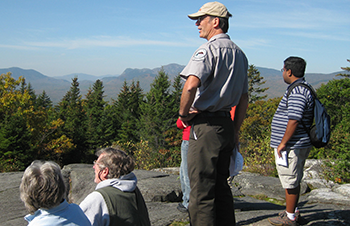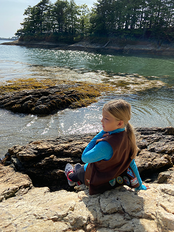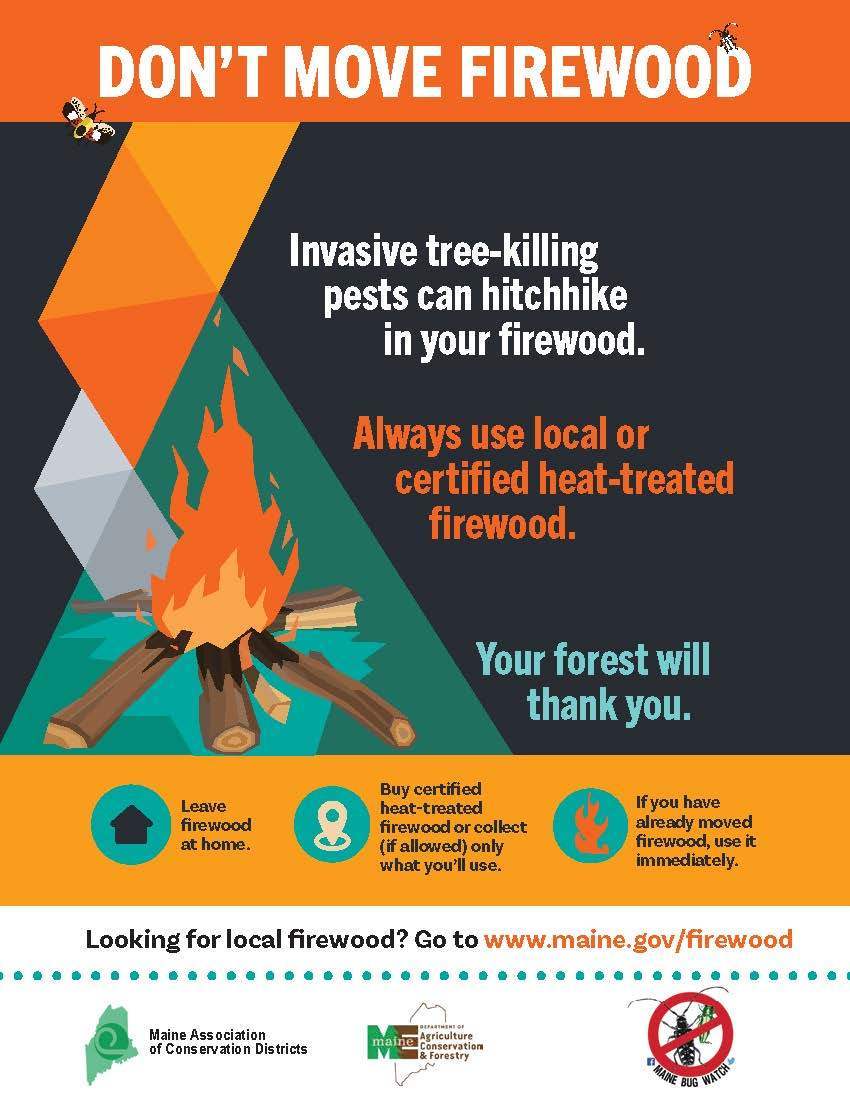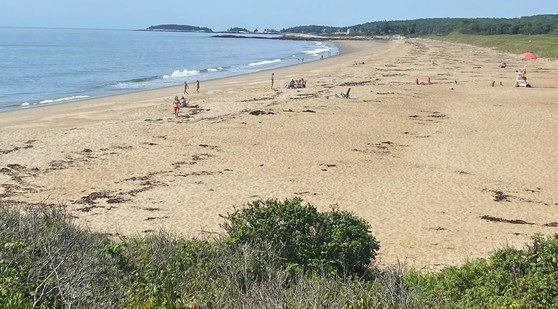 July 2022

When you work for the Bureau of Parks and Lands, there’s a lot to learn. Fortunately, we have some well-versed and seasoned instructors! I recently spent a day with 20 State Park staff as they completed a training session called Ranger Academy: Interpretation. Led by BPL Interpretive Specialist Jocelyn Hubbell, the group explored how to connect with State Park visitors through interactive stories, crafts, and demonstrations. (Plaster of Paris is not just for patching walls. It makes excellent wildlife tracks! The photo shows State Park staff learning to make wildlife tracks out of Plaster of Paris.) This Ranger Academy is one of four State Park training modules (including Compliance, Maintenance, and Operations) that prepare Park staff to be well-rounded in all aspects of their jobs.
|

Earlier this month several BPL staff joined long-time Public Lands Forester Jay Hall. We listened to his measured and thoughtful approach to managing timber, wildlife, and recreation on Nahmakanta Public Land. Decades of boots-on-the-ground experience can provide some useful perspective when it comes to growing trees! We debated the impact of ‘expanding gap’ harvests on white pine regeneration, speculated about the fate of Maine’s moose in the face of increased winter ticks, and shared our concerns about climate change and new invasive forest pests. As Jay rides off into retirement, it was a great way to pass the torch to BPL forester Kate Locke and BPL’s new Chief of Silviculture Mike Pounch. Lifelong learning takes many forms, and it keeps us all motivated and relevant in a rapidly changing world. (Photo: Foresters Jay Hall and Mike Pounch at Nahmakanta.)
~ Andy Cutko, Director, Maine Bureau of Parks and Lands
Top of page
|

There is no better work than helping others enjoy Maine's iconic State Parks and Historic Sites while enjoying the great outdoors yourself. Try it for the summer season and you may find yourself staying for a career!
|
On June 8, Governor Janet Mills joined several DACF staff and others at Camden Hills State Park to announce the launch of a $50 million initiative through her Maine Jobs & Recovery Plan. The funding will be used to rebuild infrastructure at State Parks across Maine to make them more enjoyable and accessible for Maine people and visitors. With funding from the Governor’s Jobs Plan, DACF will help address major safety and stewardship concerns, enable the parks to accommodate continued growth in visitation, and bolster the recovery of Maine's vital tourism and outdoor recreation sectors. Read more about this exciting announcement.
Top of page

All vehicles with a Maine loon license plate receive free admission to Maine State Parks and Historic Sites* on Sunday, July 17, 2022. This is a thank you to all who purchase this special plate that supports the conservation efforts of both Maine's State Parks and the Department of Inland Fisheries and Wildlife. Purchase a Loon/Conservation license plate from the Bureau of Motor Vehicles online or at your local town office.
*Please Note:
- No rain date available
- 9 AM to closing; day use only
- Open admission does not apply to Acadia National Park, the Allagash Wilderness Waterway, Baxter State Park, Peacock Beach, the ME Wildlife Park, Scarborough Beach State Park, Swan Island, the Penobscot River Corridor, or the Penobscot Narrows Observatory in Prospect, though admission to Fort Knox Historic Site will be free with the Loon Plate.
Top of page
|

Bradbury Mt. State Park, Pownal
Colonial Pemaquid State Historic Site, New Harbor
Holbrook Island Sanctuary, Brooksville
Moose Point State Park, Searsport
Mount Blue State Park, Weld
Wolfe's Neck Woods, Freeport
Top of page
|

Summer is the time to pick up your Maine State Park Passport to start on your park stamp collecting and geocaching adventures! You'll have fun exploring and can win prizes along the way.
|

Defending the Dark by Tara Roberts Zabriskie will be premiered at Maine's International Film Festival in Waterville on July 14 at 6:30 p.m. at the Railroad Square Cinema #1. The film project received a grant from the Maine Outdoor Heritage Fund and will ultimately include this documentary and three short educational videos for sharing with project partners. The Maine Bureau of Parks and Lands, one of several project partners, is looking forward to helping spread the word about the importance of dark skies to the health and wellbeing of all creatures that live on Earth. Project partner Dark Sky Maine's John Meader will treat the audience to his indoor sky tour projection after the film, and weather permitting—outdoors for a firsthand, guided tour of the night sky. View the preview and get all details at the Maine International Film Festival website.
|

Last fall the Bureau of Parks and Lands purchased a 32-mile rail line from Oakland to Embden for the purpose of creating a multi-use recreational trail. The contractor has been working for almost two months and has removed all the railroad iron from Oakland, on the south end, all the way to the Norridgewock trestle, and all but three miles from Norridgewock to North Anson! Approximately 23 miles of rail were removed. The railroad ties have been pushed out to the side so they can drive trucks in to load the rail for shipping. (Photos show the progression of the work.)
The first 1,000 tons have been loaded and shipped! We have received our first payment based on the sale of the rail minus the cost of removal. The contractor has now moved the rail removal crew to the north end and is working from the North Anson trestle south towards the Norridgewock trestle. Four excavators, a dozer and dump trucks, and a tractor-trailer are removing rails, the other steel, and the railroad ties. They are not removing steel from the three large trestles, so they are working around them.
We will be using other contractors for the maintenance work to make the trestles safe for trail users. The work on the trestle over the Kennebec, in Madison, must wait until the resident Osprey chicks have fledged and left the nest on the trestle. We are also working with IFW to address the nest issue before next season to try and prevent conflicts.
Once all the steel has been removed, they will start sorting and hauling off the railroad ties. The good ones are being marketed for landscaping timbers and the poor ones will be chipped and the material shipped to mills to be burned. Our goal is to have all demolition materials hauled away and for the North Anson and Madison trestles, as well as the other small bridges completed by October. The Norridgewock Trestle may take longer depending on planning, timing, and cost of engineering and construction.
~ Brian Bronson, Supervisor Off Road Vehicle Office and Lana LaPlant-Ellis, Outdoor Recreational Vehicle Program Planner
Top of page
|
The Bureau of Parks and Lands is seeking applications for the second round of the new Logging and Forestry Education Grant Program. Individual grant applications may be up to $50,000 and eligible applicants are limited to Maine public secondary or public post-secondary institutions or career and technical education centers that are related to logging or forestry. Programs that received funding in 2021 are not eligible for the current cycle. The total funding available for grants this cycle is up to $150,000. Given the importance of a skilled logging workforce to the sustainable harvest of timber from Maine’s Public Reserved Lands, the purpose of this logging and forestry education grant program is to assist in the career development of logging professionals.

The browntail moth has been in Maine for over a century and we are continuing to experience population outbreaks. Hot, dry conditions contribute to its population growth and spread throughout Maine. View known locations of the browntail moth on this interactive map developed by the Maine Forest Service.
Browntail moth caterpillar hairs can induce a skin rash on humans like that caused by poison ivy, and cause difficulty breathing when inhaled.
We ask everyone to review the commonly asked questions and the browntail moth updates located on the Maine Forest Service website and to also visit the Maine CDC website for more information.
Top of page
|
 |
 |
A new report by the Maine Geological Survey on the State of Maine’s Beaches in 2022 is now available. The detailed 123-page report and a series of posters analyze beach profile data collected monthly by citizen scientists at 12 of the largest beaches in Maine. Data from the last 15 months were compared to conditions since the April 2007 Patriots’ Day Storm that caused significant beach erosion. Marine geologists also compared MGS-collected annual data along the seaward edge of coastal sand dunes and the position of the mean high tide line to look at shifting shorelines and recreational beach space at the same beaches and 28 more. The shoreline data complement vertical data collected by volunteers and present locally specific information for beach management from Kittery to Pemaquid.
The study found Maine’s beaches are in very good shape for the summer season. Beach profiles showed slightly positive trends statewide. The dry beach area that geologists call a berm, and visitors call beach blanket space, held up well through a relatively mild winter with only 3 major storms in October, January, and April. Sea level was above average (since 1912) by about half a foot in the last 5 years but only at a few locations, where higher tides and waves interact with seawalls, was there a possible erosion effect. Beach and nearshore placement of sand for nourishment provided benefits in Wells, Kennebunk, and Saco that have lasted 2 to 3 years. Across the study area, beaches with natural dunes have, on average, about 35 feet more width to the recreational beach space than beaches with seawalls.
~Reprinted from a Maine Geological Survey Bulletin.
Imagine launching yourself into the air for the first time from the edge of a nest. Do your toes grip tightly just before the leap? Is there a last flapping of wings with the thought, "Are they strong enough?" Or, do you leap with abandon called by a deep instinct, and an internal cry to, "Jump and fly!" Or, is it the pleading of your winged parents and their admonishment, "It is time for you to catch your own food" that gets you up and out of the cozy nest?
I've been watching a nest of phoebes for many weeks. Their very dutiful parents have moved from the honeymoon stage of courtship to nest building, to sitting the eggs, to a now very intense feeding schedule. One sits at the nest, or on watch near the nest, while the other hunts for insects. Once the hunter is back there is an immediate changing of the guard. The nest sitter flies out, leaving the hunter to choose which gaping mouth to feed. The pair rarely get a break. It is only when the nestlings' bellies are full, and they stop gaping for food and fall asleep, that the parents get a brief respite from the feeding schedule, and a few moments to sit side by side, or get a sip of water, before starting the food flights again.
The nestlings will be on their way to fledglings when they've more feathers than down, and they've started exercising their wings in the nest. Shortly after, they will make that first leap. I'm hoping to watch the first flight from a window that overlooks the nest, but I know that it is unlikely that I will get to see that first leap. But I'll keep watching their progress, like a proud auntie, as they hop about the ground and continue to learn to fly as they build strength and their wings more fully develop. And, I'll wish them a good journey when they head out to explore the woodland edges and hope that we see each other again when I too head to the woodlands to explore.
Since I originally wrote this as a Nature Note on June 8, the phoebes have fledged. And though I missed the first flight, I have seen the fledglings and their parents occasionally over the last several weeks as they forage and sing.
~ Jocelyn Hubbell, Interpretive Specialist, Maine Bureau of Parks and Lands
The risk for HPAI in Maine remains high. If you observe a sick or dead bird, report it to a park employee. Do not handle the bird. Learn more about Highly Pathogenic Avian Influenza on the DACF Animal Health website.
Send article suggestions or newsletter comments to Jocelyn Hubbell, Interpretive Specialist, webmaster, and newsletter editor for the Maine Bureau of Parks and Lands.
|